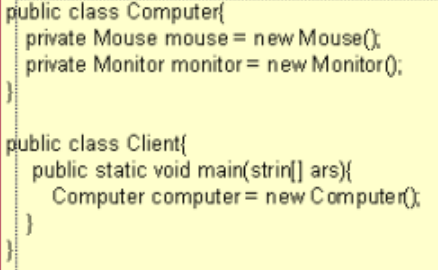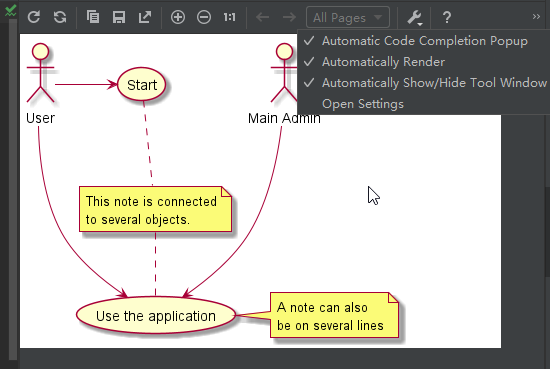Java设计模式(一)七大设计原则
设计模式包含了面向对象的精髓,“懂了设计模式,你就懂了面向对象分析和设计(OOA/D)的精要”
参考视频:https://www.bilibili.com/video/BV1G4411c7N4
应用场景->设计模式->剖析原理->分析实现步骤(图解)->代码实现-> 框架或项目源码分析(找到使用的地方) 的步骤讲解 [比如: 建造者模式 ]
编写软件过程中,程序员面临着来自耦合性,内聚性以及可维护性,可扩展性,重用性,灵活性等多方面的挑战,设计模式是为了让程序(软件),具有更好的:
- 1) 代码重用性 (即:相同功能的代码,不用多次编写)
- 2) 可读性 (即:编程规范性, 便于其他程序员的阅读和理解)
- 3) 可扩展性 (即:当需要增加新的功能时,非常的方便,称为可维护)
- 4) 可靠性(即:当我们增加新的功能后,对原来的功能没有影响)
- 5) 使程序呈现高内聚,低耦合的特性
设计模式原则,其实就是程序员在编程时,应当遵守的原则,也是各种设计模式的基础(即:设计模式为什么这样设计的依据)。设计模式常用的七大原则有:
- 1) 单一职责原则
- 2) 接口隔离原则
- 3) 依赖倒转(倒置)原则
- 4) 里氏替换原则
- 5) 开闭原则
- 6) 迪米特法则
- 7) 合成复用原则
一、单一职责原则
基本介绍
对类来说的,即一个类应该只负责一项职责。如类A负责两个不同职责:职责1,职责2。当职责1需求变更而改变A时,可能造成职责2执行错误,所以需要将类A的粒度分解为A1,A2。
案例
交通工具类
1.违背单一职责
public class SingleResponsibility1 { public static void main(String[] args) { Vehicle vehicle = new Vehicle(); vehicle.run("汽车"); vehicle.run("摩托车"); vehicle.run("飞机"); } } class Vehicle { public void run(String vechicle){ System.out.println(vechicle + " 正在路上跑"); } }
一个类混杂了所有交通工具
2.类上遵守单一职责
不同类型交通工具不同的类
public class SingleResponsibility2 { public static void main(String[] args) { // TODO Auto-generated method stub RoadVehicle roadVehicle = new RoadVehicle(); roadVehicle.run("汽车"); roadVehicle.run("摩托车"); AirVehicle airVehicle = new AirVehicle(); airVehicle.run("飞机"); } } // 不同的交通工具不同的类 class RoadVehicle { public void run(String vehicle) { System.out.println(vehicle + "在路上运行"); } } class AirVehicle { public void run(String vehicle) { System.out.println(vehicle + "在空中运行"); } } class WaterVehicle { public void run(String vehicle) { System.out.println(vehicle + "在水中运行"); } }
在类上遵守了单一职责原则,但是有缺点:
- 原来的代码改动很大,类要修改,还要修改客户端
- 程序运行成本高
3.方法级别上遵守单一职责
直接改进Vehicle类
public class SingleResponsibility3 { public static void main(String[] args) { // TODO Auto-generated method stub Vehicle2 vehicle2 = new Vehicle2(); vehicle2.run("汽车"); vehicle2.runWater("轮船"); vehicle2.runAir("飞机"); } } class Vehicle2 { public void run(String vehicle) { System.out.println(vehicle + " 在路上运行...."); } public void runAir(String vehicle) { System.out.println(vehicle + " 在空中运行...."); } public void runWater(String vehicle) { System.out.println(vehicle + " 在水中运行...."); } }
虽然在类上没有遵守单一职责原则,但是在方法上遵守了,虽然未完全严格遵守单一原则,仍可看成遵守了单一职责原则。
没有对类做大的修改,只是增加了方法。
单一职责原则注意事项和细节
1) 降低类的复杂度,一个类只负责一项职责。
2) 提高类的可读性,可维护性
3) 降低变更引起的风险
4) 通常情况下,我们应当遵守单一职责原则,只有逻辑足够简单,才可以在代码级违反单一职责原则;只有类中方法数量足够少,可以在方法级别保持单一职责原则
二、接口隔离原则
IDEA使用UML插件
搜索PlantUML Integration
百度搜索并下载安装软件 Graphviz-2.38
点击小🔧,Open Settings,设置下exutable
也可以设置环境变量,然后勾选第一个框
基本介绍
客户端不应该依赖它不需要的接口,即一个类对另一个类的依赖应该建立在最小的接口上

有ABCD四个类
B和D都实现了Interface1,具体的实现方法不同
A需要使用D类中实现的接口1、4、5方法
B需要使用C类中实现的接口1、2、3方法(A和B虽然都实现了1方法,但是具体实现不同)
由于没有实现接口隔离的原则,一个接口包含了所有方法
当类实现接口的时候,就需要实现所有方法
AB依赖这些实现接口的类,且只是需要这些类中的部分方法。当调用这些类的时候,这些类中的一些方法是冗余的,永远不会被使用。既然不会被使用,我们又何必劳心劳力的去实现它们呢?
案例
public class Segregation1 { public static void main(String[] args) { // TODO Auto-generated method stub A a = new A(); a.depend1(new B()); // A类通过接口去依赖B类 a.depend2(new B()); a.depend3(new B()); C c = new C(); c.depend1(new D()); // C类通过接口去依赖(使用)D类 c.depend4(new D()); c.depend5(new D()); } } // 接口 interface Interface1 { void operation1(); void operation2(); void operation3(); void operation4(); void operation5(); } class B implements Interface1 { public void operation1() { System.out.println("B 实现了 operation1"); } public void operation2() { System.out.println("B 实现了 operation2"); } public void operation3() { System.out.println("B 实现了 operation3"); } public void operation4() { System.out.println("B 实现了 operation4"); } public void operation5() { System.out.println("B 实现了 operation5"); } } class D implements Interface1 { public void operation1() { System.out.println("D 实现了 operation1"); } public void operation2() { System.out.println("D 实现了 operation2"); } public void operation3() { System.out.println("D 实现了 operation3"); } public void operation4() { System.out.println("D 实现了 operation4"); } public void operation5() { System.out.println("D 实现了 operation5"); } } class A { //A 类通过接口Interface1 依赖(使用) B类,但是只会用到1,2,3方法 public void depend1(Interface1 i) { i.operation1(); } public void depend2(Interface1 i) { i.operation2(); } public void depend3(Interface1 i) { i.operation3(); } } class C { //C 类通过接口Interface1 依赖(使用) D类,但是只会用到1,4,5方法 public void depend1(Interface1 i) { i.operation1(); } public void depend4(Interface1 i) { i.operation4(); } public void depend5(Interface1 i) { i.operation5(); } }
实现接口隔离原则,把接口的方法进行划分,将接口Interface1拆分为独立的几个接口,类A和类C分别与他们需要的接口建立依赖关系。也就是采用接口隔离原则
接口Interface1中出现的方法,根据实际情况拆分为三个接口
public class Segregation1 { public static void main(String[] args) { A a = new A(); a.depend1(new B()); a.depend2(new B()); a.depend3(new B()); C c = new C(); c.depend1(new D()); c.depend4(new D()); c.depend5(new D()); } } // 接口1 interface Interface1 { void operation1(); } // 接口2 interface Interface2 { void operation2(); void operation3(); } // 接口3 interface Interface3 { void operation4(); void operation5(); } class B implements Interface1, Interface2 { public void operation1() { System.out.println("B 实现了 operation1"); } public void operation2() { System.out.println("B 实现了 operation2"); } public void operation3() { System.out.println("B 实现了 operation3"); } } class D implements Interface1, Interface3 { public void operation1() { System.out.println("D 实现了 operation1"); } public void operation4() { System.out.println("D 实现了 operation4"); } public void operation5() { System.out.println("D 实现了 operation5"); } } class A { // A 类通过接口Interface1,Interface2 依赖(使用) B类,但是只会用到1,2,3方法 public void depend1(Interface1 i) { i.operation1(); } public void depend2(Interface2 i) { i.operation2(); } public void depend3(Interface2 i) { i.operation3(); } } class C { // C 类通过接口Interface1,Interface3 依赖(使用) D类,但是只会用到1,4,5方法 public void depend1(Interface1 i) { i.operation1(); } public void depend4(Interface3 i) { i.operation4(); } public void depend5(Interface3 i) { i.operation5(); } }
三、依赖倒转原则
基本介绍
- 高层模块不应该依赖低层模块,二者应该依赖其抽象
- 抽象不应该依赖细节,细节应该依赖抽象
- 依赖倒转的中心思想是面向接口编程
依赖倒转原则是基于这样的设计理念:相对于细节的多变性,抽象的东西要稳定的多。以抽象为基础搭建的架构比以细节为基础的架构要稳定的多。在Java中,抽象指的是接口或抽象类,细节就是具体的实现类。
使用接口或抽象类的目的是指定好规范,而不涉及任何具体的操作,把展现细节的任务交给它们的实现类去完成。
案例
不用依赖倒置原则
Person 接收消息
public class DependecyInversion { public static void main(String[] args) { Person person = new Person(); person.receive(new Email()); person.receive(new WeChat()); } } class Email { public String getInfo() { return "电子邮件信息: hello,world"; } } class WeChat { public String getInfo() { return "微信信息: hello,world"; } } //完成Person接收消息的功能 //方式1分析 //1. 简单,比较容易想到 //2. 如果我们获取的对象是 微信,短信等等,则新增类,同时Perons也要增加相应的接收方法 class Person { public void receive(Email email ) { System.out.println(email.getInfo()); } public void receive(WeChat weChat ) { System.out.println(weChat.getInfo()); } }
解决思路:引入一个抽象的接口IReceiver, 表示接收者, 这样Person类与接口IReceiver发生依赖
因为Email, WeiXin 等等属于接收的范围,他们各自实现IReceiver 接口就ok, 这样我们就符号依赖倒转原则
public class DependecyInversion { public static void main(String[] args) { //客户端无需改变 Person person = new Person(); person.receive(new Email()); person.receive(new WeiXin()); } } //定义接口 interface IReceiver { public String getInfo(); } class Email implements IReceiver { public String getInfo() { return "电子邮件信息: hello,world"; } } //增加微信 class WeiXin implements IReceiver { public String getInfo() { return "微信信息: hello,ok"; } } //方式2 class Person { //这里我们是对接口的依赖 public void receive(IReceiver receiver ) { System.out.println(receiver.getInfo()); } }
依赖关系传递的三种方式
接口传递
public class DependencyPass { public static void main(String[] args) { // TODO Auto-generated method stub ChangHong changHong = new ChangHong(); OpenAndClose openAndClose = new OpenAndClose(); openAndClose.open(changHong); } } // 方式1: 通过接口传递实现依赖 // 开关的接口 interface IOpenAndClose { public void open(ITV tv); //抽象方法,接收接口 } interface ITV { //ITV接口 public void play(); } class ChangHong implements ITV { @Override public void play() { // TODO Auto-generated method stub System.out.println("长虹电视机,打开"); } } // 实现接口 class OpenAndClose implements IOpenAndClose{ public void open(ITV tv){ tv.play(); } }
构造方法传递
public class DependencyPass { public static void main(String[] args) { // TODO Auto-generated method stub ChangHong changHong = new ChangHong(); //通过构造器进行依赖传递 OpenAndClose openAndClose = new OpenAndClose(changHong); openAndClose.open(); } } 方式2: 通过构造方法依赖传递 interface IOpenAndClose { public void open(); //抽象方法 }
interface ITV { //ITV接口 public void play(); }
class OpenAndClose implements IOpenAndClose{ public ITV tv; //成员 public OpenAndClose(ITV tv){ //构造器 this.tv = tv; } public void open(){ this.tv.play(); }
}
setter方式传递
public class DependencyPass { public static void main(String[] args) { //通过setter方法进行依赖传递 OpenAndClose openAndClose = new OpenAndClose(); openAndClose.setTv(changHong); openAndClose.open(); } } // 方式3 , 通过setter方法传递 interface IOpenAndClose { public void open(); // 抽象方法 public void setTv(ITV tv); } interface ITV { // ITV接口 public void play(); } class OpenAndClose implements IOpenAndClose { private ITV tv; public void setTv(ITV tv) { this.tv = tv; } public void open() { this.tv.play(); } } class ChangHong implements ITV { @Override public void play() { // TODO Auto-generated method stub System.out.println("长虹电视机,打开"); } }
小结:
- 低层模块尽量都要有抽象类或接口,或者两者都有,程序稳定性更好
- 变量的声明类型尽量是抽象类或接口,这样变量的引用和实际对象间,就有一个缓冲层,利于程序扩展和优化
- 继承时遵循里氏替换原则
四、里氏替换原则
基本介绍
继承会给程序带来侵入性,程序的可移植s性降低,增加对象间的耦合性。如果一个类被其他的类所继承,则当这个类需要修改时,必须考虑所有子类,并且父类修改后,所有涉及到子类的功能都有可能产生故障。
如何正确使用继承?里氏替换。
遵循里氏替换原则,在子类中尽量不要重写父类方法
在适当的情况下,可以通过聚合,组合,依赖来解决问题
案例
public class Liskov { public static void main(String[] args) { // TODO Auto-generated method stub A a = new A(); System.out.println("11-3=" + a.func1(11, 3)); System.out.println("1-8=" + a.func1(1, 8)); System.out.println("-----------------------"); B b = new B(); //因为B类不再继承A类,因此调用者,不会再func1是求减法 //调用完成的功能就会很明确 System.out.println("11+3=" + b.func1(11, 3));//这里本意是求出11+3 System.out.println("1+8=" + b.func1(1, 8));// 1+8 System.out.println("11+3+9=" + b.func2(11, 3)); //使用组合仍然可以使用到A类相关方法 System.out.println("11-3=" + b.func3(11, 3));// 这里本意是求出11-3 } } //创建一个更加基础的基类 class Base { //把更加基础的方法和成员写到Base类 } // A类 class A extends Base { // 返回两个数的差 public int func1(int num1, int num2) { return num1 - num2; } } // B类继承了A // 增加了一个新功能:完成两个数相加,然后和9求和 class B extends Base { //如果B需要使用A类的方法,使用组合关系 private A a = new A(); //这里,重写了A类的方法, 可能是无意识 public int func1(int a, int b) { return a + b; } public int func2(int a, int b) { return func1(a, b) + 9; } //我们仍然想使用A的方法 public int func3(int a, int b) { return this.a.func1(a, b); } }
结果
11-3=8 1-8=-7 ----------------------- 11-3=14 1-8=9 11+3+9=23
B类无意中重写了父类的方法,造成原有功能出现错误。在实际编程中,我们常常会通过重写父类的方法完成新的功能,这样写起来虽然简单,但整个继承体系的复用性会比较差。特别是运行多态比较频繁的时候。
通用的做法是:原来的父类和子类都继承一个更通俗的基类,原有的继承关系去掉,采用依赖、聚合、组合等关系代替。
public class Liskov { public static void main(String[] args) { // TODO Auto-generated method stub A a = new A(); System.out.println("11-3=" + a.func1(11, 3)); System.out.println("1-8=" + a.func1(1, 8)); System.out.println("-----------------------"); B b = new B(); //因为B类不再继承A类,因此调用者,不会再认为func1是求减法,不会混淆 //调用完成的功能就会很明确 System.out.println("11+3=" + b.func1(11, 3));//这里本意是求出11+3 System.out.println("1+8=" + b.func1(1, 8));// 1+8 System.out.println("11+3+9=" + b.func2(11, 3)); //使用组合仍然可以使用到A类相关方法 System.out.println("11-3=" + b.func3(11, 3));// 这里本意是求出11-3 } } //创建一个更加基础的基类 class Base { //把更加基础的方法和成员写到Base类 } // A类 class A extends Base { // 返回两个数的差 public int func1(int num1, int num2) { return num1 - num2; } } // B类继承了A // 增加了一个新功能:完成两个数相加,然后和9求和 class B extends Base { //如果B需要使用A类的方法,使用组合关系 private A a = new A(); //这里,重写了A类的方法, 可能是无意识 public int func1(int a, int b) { return a + b; } public int func2(int a, int b) { return func1(a, b) + 9; } //我们仍然想使用A的方法 public int func3(int a, int b) { return this.a.func1(a, b); } }
五、开闭原则
基本介绍
开闭原则是编程中最基础、最重要的设计原则
一个润洁实体如类,模块和函数应该对扩展开发(对提供方),对修改关闭(对使用方)。用抽象构建框架,用实现扩展细节。
但软件需要变化时,尽量通过扩展软件实体的行为来实现变化,而不是通过修改已有代码来实现变化。
编程中循环其他原则,以及使用设计模式的目的就是遵循开闭原则。
案例
public class Ocp { public static void main(String[] args) { //使用看看存在的问题 GraphicEditor graphicEditor = new GraphicEditor(); graphicEditor.drawShape(new Rectangle()); graphicEditor.drawShape(new Circle()); } } //这是一个用于绘图的类 [使用方] class GraphicEditor { //接收Shape对象,然后根据type,来绘制不同的图形 public void drawShape(Shape s) { if (s.m_type == 1) drawRectangle(s); else if (s.m_type == 2) drawCircle(s); } //绘制矩形 public void drawRectangle(Shape r) { System.out.println(" 绘制矩形 "); } //绘制圆形 public void drawCircle(Shape r) { System.out.println(" 绘制圆形 "); } } //Shape类,基类 class Shape { int m_type; } class Rectangle extends Shape { Rectangle() { super.m_type = 1; } } class Circle extends Shape { Circle() { super.m_type = 2; } }
如果新增画三角形,需要增加类
//新增画三角形 class Triangle extends Shape { Triangle() { super.m_type = 3; } }
绘图类要添加方法
//这是一个用于绘图的类 [使用方] class GraphicEditor { //接收Shape对象,然后根据type,来绘制不同的图形 public void drawShape(Shape s) { if (s.m_type == 1) drawRectangle(s); else if (s.m_type == 2) drawCircle(s); else if (s.m_type == 3) drawTriangle(s); } ...... //绘制三角形 public void drawTriangle(Shape r) { System.out.println(" 绘制三角形 "); } }
修改比较多
改进
把创建Shape类做成抽象类,并提供一个抽象的draw方法,让子类去实现即可,这样我们有新的图形种类时,只需要让新的图形类继承Shape,并实现draw方法即可。使用方代码不需要修改,满足了开闭原则。
public class Ocp { public static void main(String[] args) { //使用看看存在的问题 GraphicEditor graphicEditor = new GraphicEditor(); graphicEditor.drawShape(new Rectangle()); graphicEditor.drawShape(new Circle()); graphicEditor.drawShape(new Triangle()); graphicEditor.drawShape(new OtherGraphic()); } } //这是一个用于绘图的类 [使用方] class GraphicEditor { //接收Shape对象,调用draw方法 public void drawShape(Shape s) { s.draw(); } } //Shape类,基类 abstract class Shape { int m_type; public abstract void draw();//抽象方法 } class Rectangle extends Shape { Rectangle() { super.m_type = 1; } @Override public void draw() { // TODO Auto-generated method stub System.out.println(" 绘制矩形 "); } } class Circle extends Shape { Circle() { super.m_type = 2; } @Override public void draw() { // TODO Auto-generated method stub System.out.println(" 绘制圆形 "); } } //新增画三角形 class Triangle extends Shape { Triangle() { super.m_type = 3; } @Override public void draw() { // TODO Auto-generated method stub System.out.println(" 绘制三角形 "); } } //新增一个图形 class OtherGraphic extends Shape { OtherGraphic() { super.m_type = 4; } @Override public void draw() { // TODO Auto-generated method stub System.out.println(" 绘制其它图形 "); } }
六、迪米特原则
基本介绍
1) 一个对象应该对其他对象保持最少的了解
2) 类与类关系越密切,耦合度越大
3) 迪米特法则(Demeter Principle)又叫最少知道原则,即一个类对自己依赖的类知道的越少越好。也就是说,对于被依赖的类不管多么复杂,都尽量将逻辑封装在类的内部。对外除了提供的public 方法,不对外泄露任何信息
4) 迪米特法则还有个更简单的定义:只与直接的朋友通信
5) 直接的朋友:每个对象都会与其他对象有耦合关系,只要两个对象之间有耦合关系,我们就说这两个对象之间是朋友关系。耦合的方式很多,依赖,关联,组合,聚合等。其中,我们称出现成员变量,方法参数,方法返回值中的类为直接的朋友,而出现在局部变量中的类不是直接的朋友。也就是说,陌生的类最好不要以局部变量的形式出现在类的内部。
案例
//客户端 public class Demeter1 { public static void main(String[] args) { //创建了一个 SchoolManager 对象 SchoolManager schoolManager = new SchoolManager(); //输出学院的员工id 和 学校总部的员工信息 schoolManager.printAllEmployee(new CollegeManager()); } } //学校总部员工类 class Employee { private String id; public void setId(String id) { this.id = id; } public String getId() { return id; } } //学院的员工类 class CollegeEmployee { private String id; public void setId(String id) { this.id = id; } public String getId() { return id; } } //管理学院员工的管理类 class CollegeManager { //返回学院的所有员工 public List<CollegeEmployee> getAllEmployee() { List<CollegeEmployee> list = new ArrayList<CollegeEmployee>(); for (int i = 0; i < 10; i++) { //这里我们增加了10个员工到 list CollegeEmployee emp = new CollegeEmployee(); emp.setId("学院员工id= " + i); list.add(emp); } return list; } } //学校管理类 //分析 SchoolManager 类的直接朋友类有哪些 Employee、CollegeManager //CollegeEmployee 不是 直接朋友 而是一个陌生类,这样违背了 迪米特法则 class SchoolManager { //返回学校总部的员工 public List<Employee> getAllEmployee() { List<Employee> list = new ArrayList<Employee>(); for (int i = 0; i < 5; i++) { //这里我们增加了5个员工到 list Employee emp = new Employee(); emp.setId("学校总部员工id= " + i); list.add(emp); } return list; } //该方法完成输出学校总部和学院员工信息(id) void printAllEmployee(CollegeManager sub) { //分析问题 //1. 这里的 CollegeEmployee 不是 SchoolManager的直接朋友 //2. CollegeEmployee 是以局部变量方式出现在 SchoolManager //3. 违反了 迪米特法则 //获取到学院员工 List<CollegeEmployee> list1 = sub.getAllEmployee(); System.out.println("------------学院员工------------"); for (CollegeEmployee e : list1) { System.out.println(e.getId()); } //获取到学校总部员工 List<Employee> list2 = this.getAllEmployee(); System.out.println("------------学校总部员工------------"); for (Employee e : list2) { System.out.println(e.getId()); } } }
1) 前面设计的问题在于SchoolManager中,CollegeEmployee类并不是SchoolManager类的直接朋友
2) 按照迪米特法则,应该避免类中出现这样非直接朋友关系的耦合
3) 对代码按照迪米特法则进行改进.
//客户端 public class Demeter1 { public static void main(String[] args) { System.out.println("~~~使用迪米特法则的改进~~~"); //创建了一个 SchoolManager 对象 SchoolManager schoolManager = new SchoolManager(); //输出学院的员工id 和 学校总部的员工信息 schoolManager.printAllEmployee(new CollegeManager()); } } //学校总部员工类 class Employee { private String id; public void setId(String id) { this.id = id; } public String getId() { return id; } } //学院的员工类 class CollegeEmployee { private String id; public void setId(String id) { this.id = id; } public String getId() { return id; } } //管理学院员工的管理类 class CollegeManager { //返回学院的所有员工 public List<CollegeEmployee> getAllEmployee() { List<CollegeEmployee> list = new ArrayList<CollegeEmployee>(); for (int i = 0; i < 10; i++) { //这里我们增加了10个员工到 list CollegeEmployee emp = new CollegeEmployee(); emp.setId("学院员工id= " + i); list.add(emp); } return list; } //输出学院员工的信息 public void printEmployee() { //获取到学院员工 List<CollegeEmployee> list1 = getAllEmployee(); System.out.println("------------学院员工------------"); for (CollegeEmployee e : list1) { System.out.println(e.getId()); } } } //学校管理类 //分析 SchoolManager 类的直接朋友类有哪些 Employee、CollegeManager //CollegeEmployee 不是 直接朋友 而是一个陌生类,这样违背了 迪米特法则 class SchoolManager { //返回学校总部的员工 public List<Employee> getAllEmployee() { List<Employee> list = new ArrayList<Employee>(); for (int i = 0; i < 5; i++) { //这里我们增加了5个员工到 list Employee emp = new Employee(); emp.setId("学校总部员工id= " + i); list.add(emp); } return list; } //该方法完成输出学校总部和学院员工信息(id) void printAllEmployee(CollegeManager sub) { //分析问题 //1. 将输出学院的员工方法,封装到CollegeManager sub.printEmployee(); //获取到学校总部员工 List<Employee> list2 = this.getAllEmployee(); System.out.println("------------学校总部员工------------"); for (Employee e : list2) { System.out.println(e.getId()); } } }
1) 迪米特法则的核心是降低类之间的耦合
2) 但是注意:由于每个类都减少了不必要的依赖,因此迪米特法则只是要求降低类间(对象间)耦合关系,并不是要求完全没有依赖关系
七、合成复用原则
基本介绍
原则是尽量使用合成/聚合的方式,而不是使用继承
继承耦合强
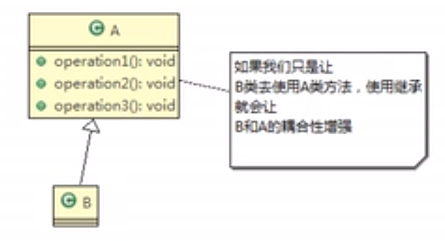
可以依赖

或聚合

或组合
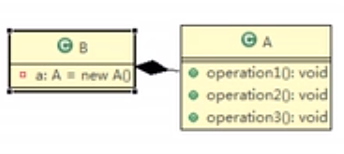
设计原则核心思想
1) 找出应用中可能需要变化之处,把它们独立出来,不要和那些不需要变化的代码混在一起。
2) 针对接口编程,而不是针对实现编程。
3) 为了交互对象之间的松耦合设计而努力。
八、UML类图
UML——Unified modeling language UML (统一建模语言),是一种用于软件系统分析和设计的语言工具,它用于帮助软件开发人员进行思考和记录思路的结果
UML本身是一套符号的规定,就像数学符号和化学符号一样,这些符号用于描述软件模型中的各个元素和他们之间的关系,比如类、接口、实现、泛化、依赖、组合、聚合等
画UML图与写文章差不多,都是把自己的思想描述给别人看,关键在于思路和条理,UML图分类:
- 1) 用例图(use case)
- 2) 静态结构图:类图、对象图、包图、组件图、部署图
- 3) 动态行为图:交互图(时序图与协作图)、状态图、活动图
类图是描述类与类之间的关系的,是UML图中最核心的
类之间的关系:依赖、泛化(继承)、实现、关联、聚合与组合
依赖:只要是在类中用到了对方,那么他们之间就存在依赖关系。如果没有对方,连编绎都通过不了
- 1) 类中用到了对方
- 2) 如果是类的成员属性
- 3) 如果是方法的返回类型
- 4) 是方法接收的参数类型
- 5) 方法中使用到
泛化关系实际上就是继承关系,是依赖关系的特例
实现关系实际上就是A类实现B接口,是依赖关系的特例
关联关系实际上就是类与类之间的联系,他是依赖关系的特例
- 关联具有导航性:即双向关系或单向关系
- 关系具有多重性:如“1”(表示有且仅有一个),“0...”(表示0个或者多个),“0,1”(表示0个或者一个),“n...m”(表示n到 m个都可以),“m...*”(表示至少m个)。
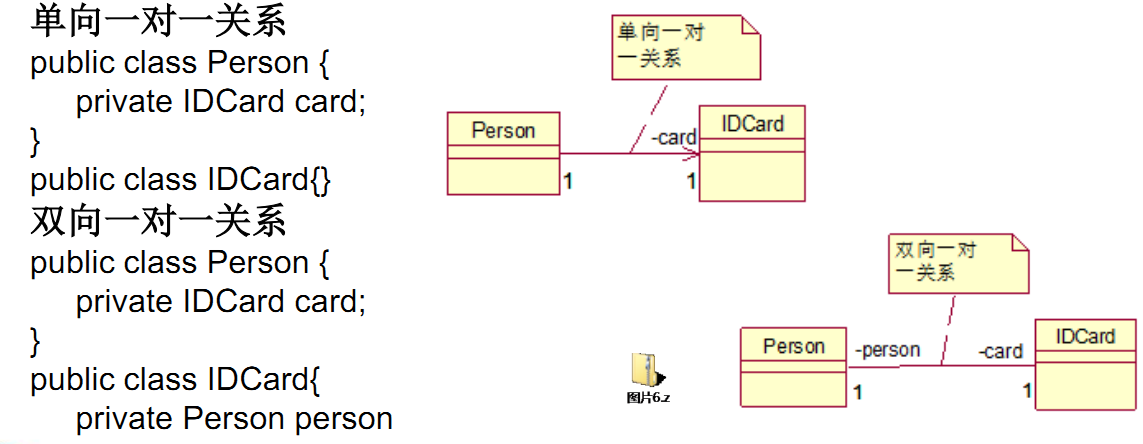
聚合关系(Aggregation)表示的是整体和部分的关系,整体与部分可以分开。聚合关系是关联关系的特例,所以他具有关联的导航性与多重性。
如:一台电脑由键盘(keyboard)、显示器(monitor),鼠标等组成;组成电脑的各个配件是可以从电脑上分离出来的,使用带空心菱形的实线来表示:

组合关系:也是整体与部分的关系,但是整体与部分不可以分开。如果我们人Mouse,Monitor和Computer是不可分离的,则聚合关系升级为组合关系。
